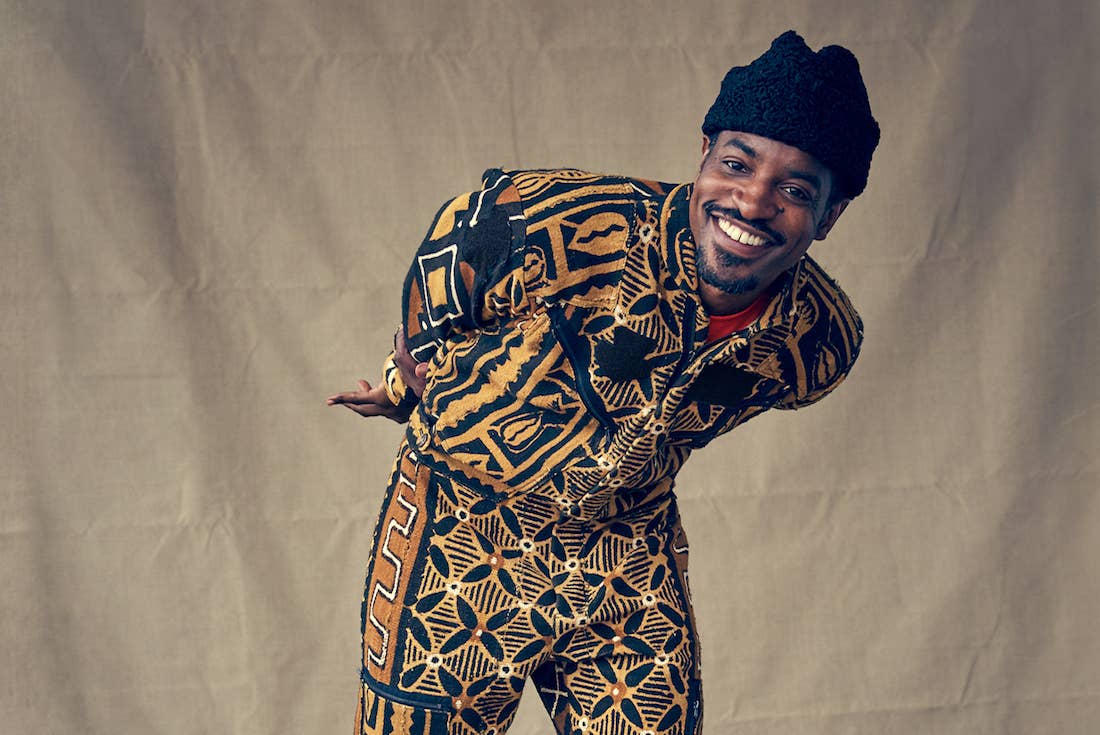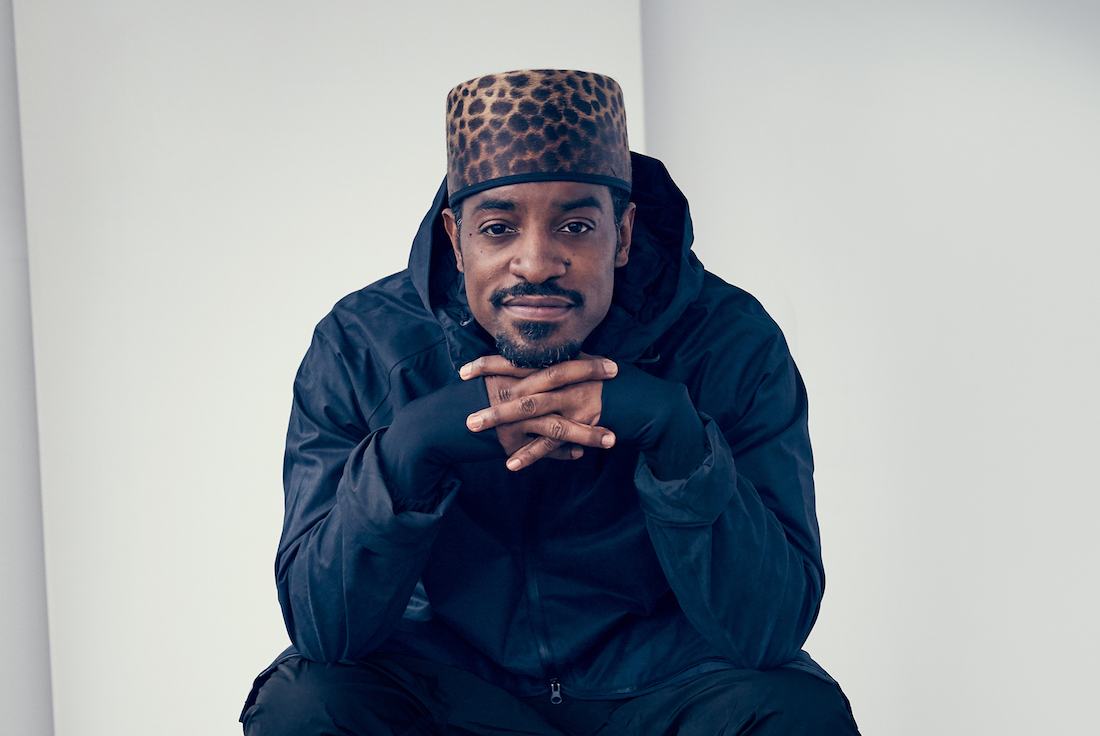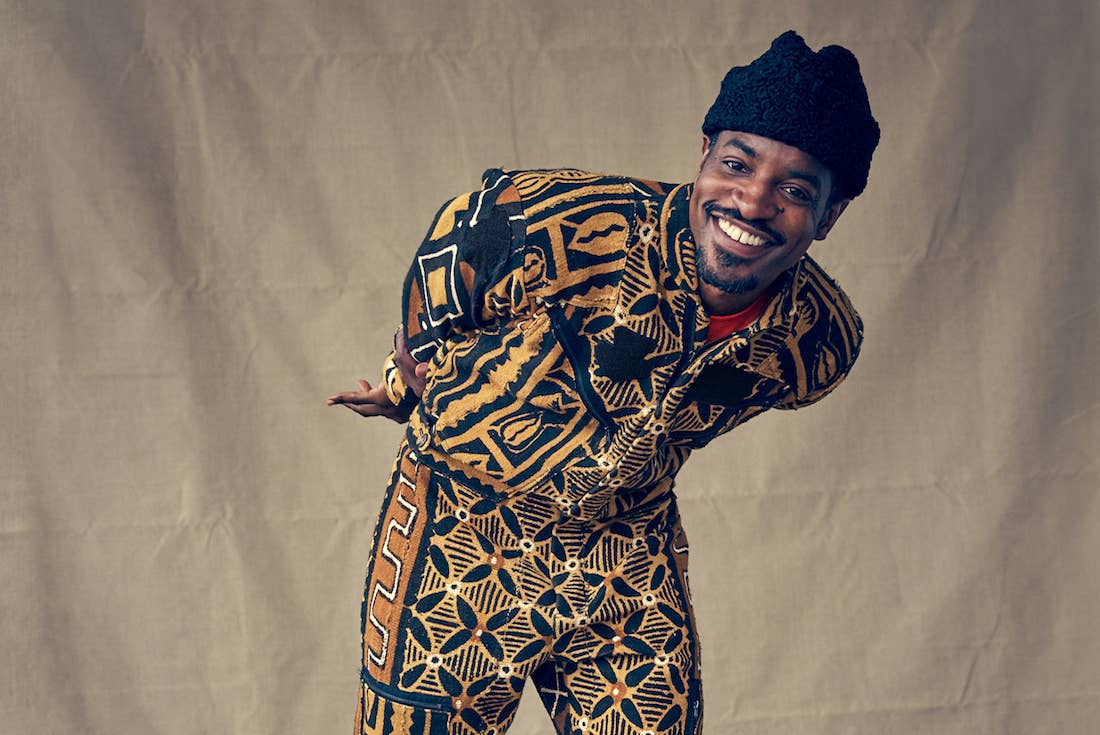
At 42 years old and with a sterling reputation as one of rap's most gifted geniuses, André 3000 can do what he likes. Today, he’s a model. On this overcast mid-June afternoon, André is in the back of the studio working with a tailor on getting a custom, black-and-mustard jumpsuit made of Malian mudcloth just right, as songs from Black Star and Kendrick Lamar play in the background. A photographer, a female model, and several assistants pace around looking antsy—the shoot is running late. But André doesn’t seem like the type to be rushed or stressed. Wearing a black skully fringed by a sprinkling of gray hairs and a blue hoodie cut off at the midriff to reveal an orange T-shirt, he glides over to a nearby sofa, sits down, and smiles. Post Malone’s “Congratulations” is blasting over the speakers; André looks right at home, and is getting nostalgic.
“In Atlanta, there was the prep movement—the look was golf clothes, tennis clothes, Ralph [Lauren]. You had prep crews that would fight, kind of like a 1950s car gang,” says André, sitting in an airy Manhattan photo studio overlooking the Hudson River. “You’d have one high school over here with their crew, then you had another school with their crew. One was called the Stray Cats—Cee-Lo was in the Stray Cats. Their uniform was very high hair dyed bleach-blonde, plaid Ralph Lauren pants, Polo shirts, and tennis racquets. You would wear tennis racquets to school—not to play tennis, but to fight. Your tennis racquet was like a weapon.”
André isn’t taking this trip down memory lane to ‘80s Atlanta for a comeback album—not the Outkast reunion album with Big Boi that everyone relentlessly asks him about, nor the solo album there's rampant speculation about, fueled by his sporadic, standout guest verses (which in recent years have blessed releases from Frank Ocean, Travis Scott, and Erykah Badu, the mother of his son Seven). André Benjamin has a new creative outlet, one that ties directly back to his style memories from growing up in Atlanta: sneaker design.
In February, footwear brand Tretorn announced that André 3000 would be its Creative Director: his immediate duties include being the face of their Fall 2017 campaign, designing his own 2018 capsule collection with help from streetwear icon Jeff Staple, and leading the the 50th anniversary celebration of Tretorn’s most iconic shoe, the Nylite. The shoe's birthday will feature 50 different artists, including André and Staple, customizing their own pairs and unveiling them at ComplexCon in November. Overall, according to Staple, André will be “sprinkling his magic dust” across everything the brand does.
The connection between a legendary Atlanta rapper and a Swedish sneaker brand founded in 1891 that hasn’t been “in” for decades isn’t as tenuous as one might think. Popularized by the likes of tennis great Bjorn Borg, Jackie O, Farrah Fawcett, and Billy Joel, Tretorn’s Nylite tennis low-top was a staple of 1970s and 1980s WASP-y prepdom. They were the go-to shoe for Black preps in Atlanta too, André says (he usually would wear his with Guess overalls)—but they put their own twist on the shoes. “What the kids would do is take white Nytlites and buy dye from the grocery store, and you’d dip-dye your shoes so you would have your own colors,” he remembers. “You’d have green Tretorns, you’d have orange Tretorns; Tretorn wasn’t even making these colors yet. It was a whole big dyeing thing. When I first met Big Boi, I dyed some pants for us; I think I dyed my pants orange and I dyed his turquoise.”
But André wasn’t just wearing and dyeing Tretorns—a lifelong avid sketcher with a vivid imagination, he was designing them, in his head, from an early age. “I’ve been drawing and sketching since I was a little kid. When I was small I would draw in class—sketch shoes, naked women, cars, all this type of stuff. I have pictures of me sketching Tretorns.”
“Finding somebody that had such an authentic and organic connection to the brand—it took us a long time,” Tretorn’s EVP of Marketing Natasha Fishman tells me days later. “When André told us his story, I remember saying out loud, ‘You can’t make this stuff up!’”
Some of André’s youthful drawings are now forming the blueprint for his 2018 Tretorn line. “I had so many cool sketches,” he explains, “I was like, well, let me just see what I can take directly from my sketchbook and give to the factory to see what they can make. I wish I had brought my sketchbooks with me...”
He reaches for his phone and quickly flips through photos of prototypes. There’s a high-top in what appears to be green terrycloth, another in mudcloth-like material similar to the jumpsuit he’s having tailored, and another with thick yellow and blue rugby-like stripes that will surely make some of André’s old prep friends happy. He shows me an image of a shoebox featuring the words “André Benjamin will not draw in class” in his own writing—“‘cause I used to draw a lot in class and get in trouble,” he explains. “If you’re a collector of art you could just save the box!”
“Even the tissue paper will have a whole plethora of just wicked designs, drawings on it,” he adds, showing off a picture of shoebox paper emblazoned with a drawing of a sci-fi-looking insect, what André describes as an “ant with a rugby shirt on.”
“It’s not colorway-playing on existing models,” Staple, whose creative agency Staple Design was hired as a consultant by Tretorn late last year, tells me over the phone. “It’s reconstruction of every mold, upper, outsole, from the ground up. I’ve got to give it up to Tretorn for being open to everything André wanted to do. Even the Nylite, which is their most iconic silhouette, has been reconstructed. It would be like a Nike collaborator saying, ‘Let’s redo the Air Force One.’”
"That’s one of my mottos: 'Don’t let people get too comfortable with what you’re doing.'"
“For this line, it’s really my sketchbook,” André says. “What’s that book, Harold and the Purple Crayon? Where anything he drew came to life? I start most things from a sketchpad, and that’s really my inspiration. Just a blank white sheet brainstorming, coming from a pure kind of kid [mindset], rather than seeing something on the street and copying it.”
But André concedes that he does get inspired by what he sees on the street—particularly in New York. A lifelong Atlanta native, he currently spends most of his time in Lower Manhattan with his girlfriend (Staple says André relocated to New York for the time being to work closely with him on Tretorn). “Walking around the city is super-inspiring,” André says. “You always see dope people on the street. I live not too far from SoHo, so I see the hip new kids. Then nearby, you got the real street Italian gangsters, where [Martin] Scorsese and them grew up [in Little Italy]. Then you see all the cool kids standing in line at the Supreme store.”
His favorite area, however, seems to be Chinatown. “I’ve been really inspired by old people there, because there’s a certain comfort in the things they wear. They wear jogging pants. It’s like, I’m so comfortable, I don’t care what you think about what I’m wearing. I was telling [Young Thug] this—you can get style from children and old people, because they don’t give a fuck. I walk through Chinatown every day—early in the morning and midday. I’m told not to go walking there late night.”
Another inspiration, both stylistically and musically, is the aforementioned Young Thug, the fellow Atlanta MC whose eccentric mix of rapping, singing, and androgynous styling is arguably a direct descendant of André’s. “He’s exciting,” André says of Thug. “There’s no box. He’s all over the place. To do those things he does, you have to have big fuckin’ balls. It’s almost harder than the guy who’s portraying hard, you know? It’s kind of mind-fucking people. It’s saying, don’t get too comfortable with me. That’s one of my mottos: Don’t let people get too comfortable with what you’re doing.”
Thug reminds André of what he calls his own biggest style risk, when he played The Chris Rock Show in white briefs, ski boots, and a rainbow pipe-cleaner cape. It was back in 2000, when the MC uniform mostly consisted of white T-shirts or sports jerseys, baggy jeans, and fitted baseball caps. “It was actually a mistake,” he says with a laugh. “I had pants, but we don’t know what happened to them. I don’t know if I left them at the hotel. It was 20 minutes before we had to go on and everyone was like, ‘I dare you to [go on without them].’ I was like, ‘Fuck it.’ But I was actually terrified.”
André’s partnership with Tretorn isn’t his first foray into designing, of course. In 2008, he launched menswear line Benjamin Bixby, which was also inspired by a prep aesthetic, but from several decades prior—Ivy League sportswear of the 1930s. The brand was hailed by critics and embraced by retailers like Barney’s, but folded just a year later. Before that, in 2002, André and Big Boi announced Outkast Clothing Co., but the brand never really took off commercially or critically, and the duo was rarely seen wearing it. André says they were barely involved. [“It was] kind of just like a company comes and says, ‘Hey, we want to make clothes for you.’ Okay, cool, whatever.”
If André’s sketches are any indication, his partnership with Tretorn isn’t anything like that. “This isn’t just a celebrity signing the check—he’s so involved it’s almost annoying,” Staple says, laughing. “He works all the time with his sketchbook open and a marker in his hand; he’s constantly drawing. My job is to take his vision and make it a thing a factory can understand. I’ll give my two cents when he asks, but I really let him drive the ship.”
Staple recalls his first one-on-one meeting with André after he signed with Tretorn. “He was like, I’ve been out of the game for a long time. How do I get back in fast? It happened to be the week of Vegas Agenda season; there’s [the streetwear trade shows] Project, Liberty Fairs, Capsule, and Agenda, all in the same week. So I was like, I’m going to Vegas this week and I don’t think there’s a better way to get a full crash course of this industry. He was like, ‘Alright, bet.’ I was half expecting him to not even show up, but he landed in Vegas at midnight like, ‘I’ll just hop in an Uber and meet you at the Cheesecake Factory.’ I’m still thinking he’s fucking with me and he’s going to bail, or that he’s going to show up with an entourage of like 20 people in tow. And then up walks André, sauntering in by himself at 1:30 a.m., fresh off a flight. That’s how intimately involved he is in all of this.”
As intensely personal and inward as much of André’s work is—from Outkast verses about being born “into this world high as a bird, from second-hand cocaine powder” to sneakers based on childhood scribblings—close collaboration with others seems to suit him best. His five-album run with Big Boi is arguably hip-hop’s best, most consistent discography. Since Outkast’s 2006 soundtrack to Idlewild, their final full-length collaboration, André’s sole musical output has been scattered guest verses on other people’s songs. He’s mainly busied himself with fashion and acting instead, taking on two major roles in projects by writer-director John Ridley: the ABC drama American Crime (with a recurring role playing the husband to star Regina King’s character) and the long-gestating 2013 film Jimi: All Is By My Side, in which he received near universal accolades for his spacey star turn as Jimi Hendrix.
“With acting and fashion design you’re dealing with so many other people,” André says. “In acting, you’re with maybe 100 other people—your director, casting director, makeup. You have to sit back and have more of a conversation with people. And I work better with other people. I clearly see that now. Like, I haven’t put out an album in years, but if Frank Ocean or Travis Scott calls and says, ‘Hey, man, I want you to be a part of this,’ it’s like I have a goal, a target. When I’m on my own, I’m sitting around twiddling my thumbs, like, ‘Ah, I’ll do it tomorrow.’ It’s different. There’s a kind of certain magic when you work with other people."
“Rapping is like being a boxer. No matter how great you are or were at a certain time, the older you get, the slower you get—I don’t care who you are. And I can feel that coming on."
This begs an obvious question: Why not make more music with Big Boi, the collaborator with whom André made his best, most consistent and most influential work so far? (At the very least, it would finally make fans and journalists stop asking him about it.) The answer: At the age of 42, André says rapping only inspires him in fleeting moments now. “It’s really just an excitement thing, and where I am in life. I kind of like not being a part of [rap], now that I’ve done it. As I get older, I start to see myself move more back from it—the hustle and bustle of putting out an album, the pressure of being in the studio trying to come up with something. Now it’s more like a hobby for me, so I don’t think about it in that way. Even with Outkast — if we never do another album, I’m totally fine with that. When I was 25, I said I don’t want to be a 30-year-old rapper. I’m 42 now, and I feel more and more that way. Do I really want to be 50 years old up there doing that? When I watch other rappers that are my age I commend them, but I just wonder where the inspiration is coming from. At this stage I’m really more focused on what I am going to be doing 10 years from now. And I hope to God it won’t be rapping.”
Unlike André, Big Boi has stayed busy musically, releasing four solo albums in the past seven years, touring heavily, and launching a new project, Big Grams, with indie electro-rock duo Phantogram. In 2014, Outkast reunited for a festival tour that grossed $60 million, but afterward André told the Fader he “felt like a sellout.” Since then, one can assume that other large paychecks have been turned down while André focuses on projects like Tretorn. Does that ever cause any tension between Big Boi and him? “We have such an understanding that it’s never friction,” André replies. “There’s never pressure of, ‘Hey, man, let’s get back in.’ Of course there’s always money on the table, but it’s never seen that way. We’ve been blessed to not have to scratch for that money. Maybe it’ll be an issue in the future, but maybe not.”
“Rapping is like being a boxer,” André continues. “No matter how great you are or were at a certain time, the older you get, the slower you get—I don’t care who you are. And I can feel that coming on. There’s always a new wave of artists, and sometimes I’m just like, ‘I’m good. I’ll let the young guys do it.’ And whenever they reach out and say, ‘Hey, let’s try something,’ I’m with helping them. I’m doing it more for them than for my own self. I don’t get much happiness from doing music like that—I get happiness from pleasing who I’m working with, and helping them, and seeing them be excited.”
André still spends a lot of time working on music on his own—but it isn’t rap. In between his Tretorn work, he’s taking music theory classes, and after picking-up guitar to play Hendrix on-screen, he’s learning to play a couple new instruments, though he declines to reveal which. Instruments interest him, he says, because “you have the same kind of emotion and input, but less from the verbal side of things.”
When asked if he’ll be applying these burgeoning skills to any new projects, he says, “I have no idea—I’m going with the flow. [I’m] just trying to find something that I can do still.” He frequently noodles around on the piano, “making up shit on the spot, almost like how I rap or freestyle. It’s just chords—I don’t know what’s happening. I go back and listen to these freestyles and want to play them over again, so now I’m trying to get someone to help me transcribe so I can learn my own stuff.”
Still smiling serenely, André is obviously in a philosophical mood. The conversation starts to drift, from monogamy and love, to the Cloisters museum in Upper Manhattan, to Jay-Z’s Songwriter Hall of Fame induction (“He’s the king,” André says), before a publicist interrupts: The clothes are ready, and it’s finally time to shoot. After changing into that custom mudcloth jumpsuit, a fez, and a pair of sharp navy-blue suede Nylites, André sticks his hip boldly to the side and flashes his brightest smile yet—this time for the camera. He’s a natural. Just 45 minutes and a couple more looks later, it’s a wrap.
“I still love music, but I’m trying to find that deeper thing,” André says, stepping off set to change back into his street clothes. “The older I get, it’s really more about comfort, personal happiness, and understanding. Maybe one day I’ll be somewhere talking about it in a class or something. I don’t know the rest of my way.”


